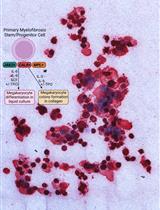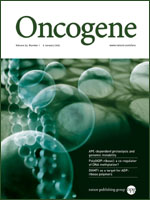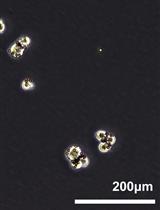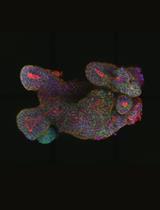- EN - English
- CN - 中文
Osteogenic and Adipogenic Differentiation of Osteosarcoma Cells
骨肉瘤细胞的成骨和生脂分化
发布: 2012年12月20日第2卷第24期 DOI: 10.21769/BioProtoc.308 浏览次数: 21776

相关实验方案

来自骨髓增生性肿瘤患者的造血祖细胞的血小板生成素不依赖性巨核细胞分化
Chloe A. L. Thompson-Peach [...] Daniel Thomas
2023年01月20日 2302 阅读
Abstract
Osteosarcomas are the most common primary, non-hematologic malignant tumors in childhood and adolescence, comprising almost 60% of all bone sarcomas. Although these tumors are osteoblastic in nature, the characteristics of the specific tumor-initiating cells are unclear. Osteosarcomas contain highly proliferative undifferentiated malignant cells with a disrupted bone differentiation program. Cancer stem cells (CSCs) that have tumor-initiating properties and capacity of symmetric and asymmetric division have now been described in many solid tumors. For osteosarcomas, the CSC hypothesis has received support from recently reported findings that both human and murine osteosarcomas contain a sub-population of multipotent cells that that express various mesenchymal stem cell surface markers and are capable of undergoing differentiation in multiple mesenchymal lineages such as osteoblasts and adipocytes. Differentiation into these different lineages can be easily assessed by growing cells in specific medium and assaying for differentiation markers.
Materials and Reagents
- Osteosarcoma cells (Basu-Roy et al., 2012)
- DMEM - high Glucose from Invitrogen (Life Technologies, Invitrogen™, catalog number: 11330-032 )
- Fetal bovine serum (FBS)
- Penicillin-streptomycin
- Beta-glycerol phosphate (Sigma-Aldrich, catalog number: G9422 )
- Ascorbic acid (Sigma-Aldrich, catalog number: A4034 )
- Earle's balanced salt solution (EBSS) from Invitrogen (Life Technologies, Invitrogen™, catalog number: 14155-063 )
- HCl
- Ethanol
- DMSO (Sigma-Aldrich, catalog number: D8418 )
- Phosphate buffered saline (PBS)
- Paraformaldehyde
- Isopropanol
- Acetone
- Double-distilled H2O (ddw)
- Citrate concentrated solution (20 ml) (Sigma-Aldrich, catalog number: 854C )
- Naphthol AS-MX phosphate alkaline solution, 0.25% (20 ml) (Sigma-Aldrich, catalog number: 855 )
- COMPLETE capsule of Fast Blue RR salt (Sigma-Aldrich, catalog number: FBS25-10 CAP )
- Oil-Red-O (Sigma-Aldrich, catalog number: O0625 )
- Mayer's HemTox stain (Sigma-Aldrich, catalog number: MHS1 )
- Alizarin Red S certified by the biological stain commission (Sigma-Aldrich, catalog number: A5533 )
- Beta-glycerol phosphate stock solution (see Recipes)
- 1,000x ascorbic acid solution (see Recipes)
- Dexamethasone (Sigma-Aldrich, catalog number: D4902 ) (see Recipes)
- 3-Isobutyl-1-methylxanthine (IBMX) (Sigma-Aldrich, catalog number: I5879 ) (see Recipes)
- Indomethacin (Sigma-Aldrich, catalog number: I8280 ) (see Recipes)
- Insulin (recombinant human) (Sigma-Aldrich, catalog number: I2643 ) (see Recipes)
- Fixation solution (see Recipes)
- Staining solution for osteogenesis (see Recipes)
- Oil-Red-O stock solution (see Recipes)
- Staining solution for mineralized osteoblasts (see Recipes)
Equipment
- Tissue culture set up
- Pasteur pipette
- Pasteur pipette tip
- Light microscope
- Pall Life Sciences acrodisc ayringe filter (0.2 μM HT Tuffryn membrane low-protein binding non-pyogenic) (Life Sciences, catalog number: PN 4192 )
- 0.2 μM nylon filter
- 24-well plates
Procedure
文章信息
版权信息
© 2012 The Authors; exclusive licensee Bio-protocol LLC.
如何引用
Basu-Roy, U., Basilico, C. and Mansukhani, A. (2012). Osteogenic and Adipogenic Differentiation of Osteosarcoma Cells. Bio-protocol 2(24): e308. DOI: 10.21769/BioProtoc.308.
分类
癌症生物学 > 癌症干细胞 > 细胞生物学试验 > 细胞分离和培养
细胞生物学 > 细胞分离和培养 > 细胞分化
您对这篇实验方法有问题吗?
在此处发布您的问题,我们将邀请本文作者来回答。同时,我们会将您的问题发布到Bio-protocol Exchange,以便寻求社区成员的帮助。
Share
Bluesky
X
Copy link










